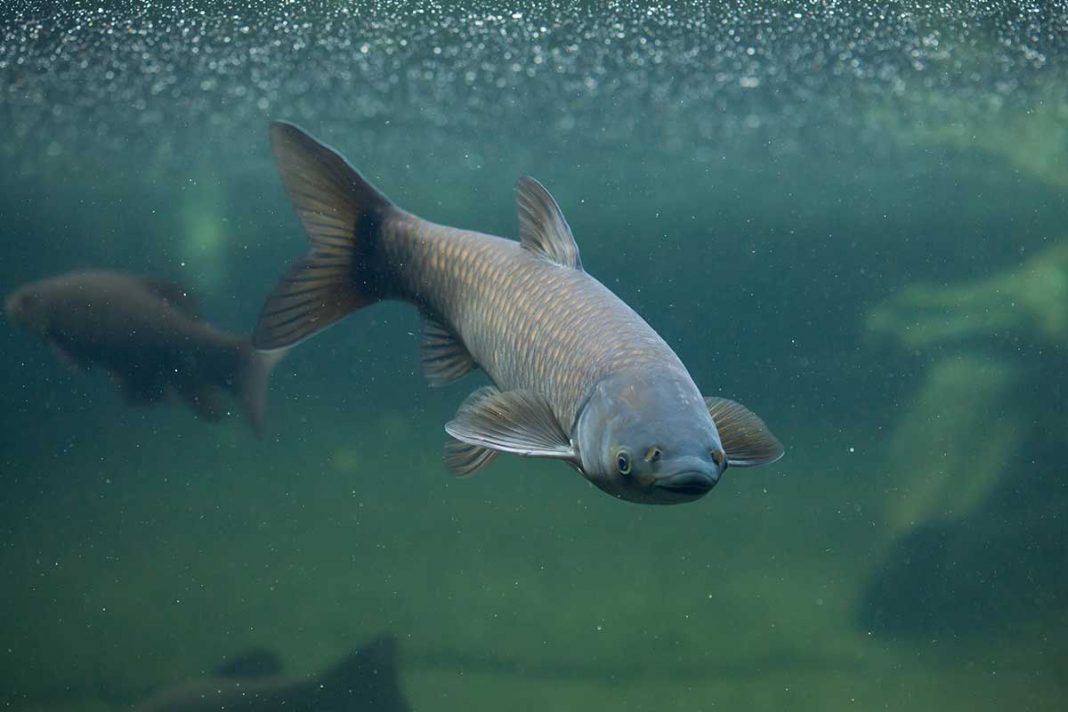MANITOULIN – Asian carps have the potential to devastate the Great Lakes if as few as 10 mature females and 10 or fewer males were to reach any of the Great Lakes and the anticipated impacts of climate change could exacerbate the risk. The Invasive Species Centre (ISC) hosted a virtual forum on March 3 that addressed concerns about this invasive species.
The Great Lakes are worth an estimated $13 billion annually, said Jill Thatcher, communications co-ordinator for the ISC, in a release. “Asian carps have the potential to devastate the Great Lakes ecologically and economically if they were to establish. They grow very large very quickly with huge appetites to match and would easily outcompete native species for food and resources. Asian carps would negatively impact angling by decreasing biodiversity of popular angling species, boating by reducing water quality, and other forms of recreational water use.”
Jennifer Wright-Kavanaugh, a senior biologist with Fisheries and Oceans Canada (DFO) noted that Asian carps are among the top aquatic invasive species being monitored in Canada and for their potential arrival into the Great Lakes. “Fisheries and Oceans Canada takes these threats very seriously and is committed to responding quickly and effectively,” she said.
DFO has had an Asian carps program since 2012 and works with partners in the United States and Ontario’s Ministry of Natural Resources and Forestry to protect the Great Lakes. The program was initiated following the release of a 2011 DFO report that presented a breakdown of all the possible pathways for Asian carps to arrive at the Great Lakes and assessed their chances for long term survival once they had arrived. There are four species of concern: grass carp, bighorn carp, black carp and silver carp. Of the four species, grass carp is the most imminent threat to great lakes now, said Ms. Wright-Kavanaugh.
According to the ISC, establishment needs the presence of a self-sustaining population, which means the carps have spawned within the Great Lakes basin and have then successfully reproduced. There are suitable spawning tributaries located in all the Great Lakes. In Canada, there are 41, including several on the North Shore and in the Georgian Bay area, and 22 in the American Great Lakes basin. The timeframe and direction of population growth estimates vary depending on where they arrive within the basin but it is predicted to be less than 10 years for spread with direction likely Michigan to Huron to Erie. The expected arrival timeframe is less than five years after arrival into the connected Great Lakes basin via Lake Michigan.
Grass carp were initially stocked for the purposes of aquatic vegetation control. The other species (bighead, silver and black carp) were introduced to the Southern US in the late 1960s and 1970s for use as biological control in aquaculture facilities based on their specific diets. Flooding events allowed them to escape and eventually make their way into the Mississippi River basin. Our changing climate, including the likelihood of increased flood events, can provide new opportunities for the fish to become established in the Great Lakes.
Erik Dean, a third-year Ph.D. student at the University of Toronto, Scarborough campus, discussed how temperature can affect development of Asian carps, how changes in heavy rainfall patterns can affect reproduction and how both factors will affect the invasion process from arrival to impact. “Temperature affects development and that will ultimately affect the population growth rate. Populations can ultimately grow larger as a result and generally how this can affect survival, establishment, spread and impact,” he said. He also discussed precipitation, specifically how changes in heavy rainfall patterns can affect reproduction.
“Climate change can have effects upon temperature pattern in a few different ways,” said Mr. Dean. “We can see increasing variations in temperature and we are also seeing an increase in mean. Climate change is probably going to be presenting us with a combination of both mean and variation. What that will result in is even more record hot weather. There will still be some cold weather, just less of it.”
How does this affect Asian carps? Chemical reactions can happen at different rates depending on temperature, he said. “The warmer it is the faster their metabolism, which is the basis for critical processes like growth and sexual maturation. You can say then that the metabolism is the speed of living. For mammals like us, we keep our body temperature at a fairly comfortable constant. Our speed of living therefore is also fairly constant. For animals whose body temperatures are controlled by the environment, like fish, their metabolisms will gear up under warmer conditions. It follows, then, if metabolism is the speed of life, fish are in essence living more of their lives on a hot day than on a cold day. Warmer conditions bring about faster growth which can lead to achieving larger body sizes. Larger body sizes can lead to greater rates of survival.”
A faster metabolism speeds up development, meaning maturity can be reached earlier in life. This in turn leads to a smaller adult size because growth starts to taper off after maturation, he said. Smaller adults don’t produce as many eggs as large fish do.
Mr. Dean’s research shows what kind of population growth we can expect and prepare for in the future as areas continue to warm up over time. “Warmer temperatures are expected in the southern areas of the Canadian Great Lakes basin, which means that the environmental conditions in the Great Lakes support faster development with the fish reaching sexual maturity earlier leading to faster population growth. Generally, increased temperatures can lead to more growth early in life leading to more maturity which can increase their life cycle. Of course, larger populations have a greater potential to spread and especially as conditions get warmer and more suitable, this will exacerbate the impact.”
“Incidentally,” he added, “maturation at age three is what we’re observing in the Mississippi River where these bighead carp are extremely abundant. We can expect similar conditions on our side of the border in the future. Bighead carp have higher numbers in warmer regions in the United States today and within the next 60 years we can expect the Great Lakes basin to have a climate similar to those regions. Hotter temperatures may mean that in the future we’ll see a risky rate of population growth on our side of the border.”
“These anticipated hotter temperatures also have an effect on precipitation. Warmer air can hold exponentially more moisture than cold air which can affect how often it rains and how much it does in a given storm, so this has an impact on Asian carps because of how they spawn. In Asia, they’ve been observed to spawn from April to June in fast flowing water and one of those important cues to start spawning is a rise in water level. So, increased rainfall can give them the conditions necessary to reproduce.”
The effects of climate change can be very regional with northern latitudes warming faster than anywhere else. In fact, Canada is warming at a rate two times the global rate. This is through a process called polar amplification. Polar amplification results from positive feedback caused by the melting of ice caps which reinforces global warming which amplifies ice loss. This in turn will affect the jet stream, a strong stream of air that moves weather systems across the continent from west to east.
“Due to disturbances in the jet stream we can expect extended periods of rainfall and sudden high intensity rainfall events,” Mr. Dean said. “This can lead to more high flows and water levels become more frequent. With the increasing frequency and severity of floods there can be increasing opportunities for Asian carps south of the border to go over top of barriers and advance northward. Less overall precipitation is expected under warmer conditions but there will be more extreme precipitation events causing flooding and this type of precipitation specifically may provide more opportunity for spawning and increased reproduction.”
Increased precipitation could also increase agricultural fertilizer runoff, meaning more food and higher rates of survival for Asian carps. The four species thrive in different habitats and have different diets. They have a very wide tolerance range for water temperatures, from sub-tropical to temperate zones. There have been Asian carps found in Siberia and in the 30°C temperatures on China’s Yangtze River.
Researchers DFO and other government agencies as well as the University of Toronto, Scarborough are searching for ways to prevent and mitigate their arrival in the Great Lakes, including through physical and sound barriers. Everyone can do their part to remain vigilant and learn to identify and report Asian carps.





